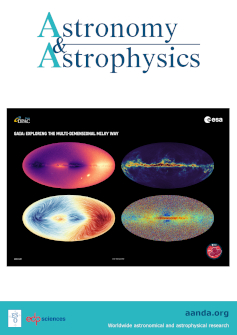A dusty magnetospheric stream explaining the light curves of the dipper objects: Finding a new inclination threshold to produce dippers
IF 5.4
2区 物理与天体物理
Q1 ASTRONOMY & ASTROPHYSICS
引用次数: 0
Abstract
Context. The so-called “dippers” are young stellar objects that exhibit dimming episodes in their optical light curves. The common interpretation for the occurrence of these dips is that dusty regions periodically or quasi-periodically cross the line of sight toward the object.Aims. We develop a model where we assume that these regions are located at the intersection of the magnetospheric stream with the disk. The stream is fed by gas and dust coming from the disk. As the material follows the magnetic field lines above the disk plane, it forms an opaque screen that partially blocks the stellar emission. The amount of extinction caused by the material crossing the line of sight depends on the abundance and location of the dust along the stream, which depends on the degree of dust evaporation due to the heating by the star.Methods. We run hydrodynamical simulations of dusty accretion streams to produce synthetic dipper light curves for a sample of low-mass young stars still accreting from their disk according to evolutionary models. We compare the distribution of the light curve amplitudes between the synthetic sample and observed samples of dippers from various star-forming regions.Results. Dust evaporation along the accretion column drives the distribution of photometric amplitudes. Our results suggest that most of the observed dippers correspond to systems seen at high inclination. However, dust survival within accretion columns may also produce dippers at lower inclination, down to about 45°. We find that the dust temperature arising from stellar irradiation should be increased by a factor 1.6 to find consistency between the fraction of dippers our model predicts in star-forming regions and the observed fraction of 20–30%.Conclusions. Transient dust survival in accretion columns appear as an alternative (or complementary) mechanism to inner disk warp occultation in order to account for low-inclination dippers in star-forming regions.解释北斗七星天体光变曲线的尘埃磁层流:寻找产生北斗七星的新倾角阈值
背景。所谓的 "凹陷 "是指在光学光曲线上出现暗淡现象的年轻恒星天体。对这些暗淡现象的常见解释是,尘埃区域周期性或准周期性地穿过天体的视线。我们建立了一个模型,假定这些区域位于磁层流与磁盘的交汇处。磁层流由来自磁盘的气体和尘埃提供能量。当这些物质沿着磁盘平面上方的磁场线移动时,就形成了一个不透明的屏幕,部分阻挡了恒星的发射。穿过视线的物质所造成的消光量取决于尘埃流的丰度和位置,而尘埃流的丰度和位置又取决于恒星加热所造成的尘埃蒸发程度。我们对尘埃吸积流进行流体力学模拟,根据演化模型为仍在从星盘吸积的低质量年轻恒星样本合成北斗七星光曲线。我们比较了合成样本和来自不同恒星形成区的观测北斗星样本的光曲线振幅分布。沿吸积柱的尘埃蒸发推动了光度振幅的分布。我们的结果表明,大部分观测到的倾角星都对应于在高倾角下观测到的系统。然而,吸积柱内的尘埃生存也可能在较低倾角(低至约 45°)下产生倾角。我们发现,恒星辐照所产生的尘埃温度应提高 1.6 倍,这样才能使我们的模型所预测的恒星形成区中的倾角与观测到的 20%-30%的倾角保持一致。吸积柱中的瞬态尘埃存活似乎是内盘翘曲掩星的一种替代(或补充)机制,以解释恒星形成区中的低倾角倾角现象。
本文章由计算机程序翻译,如有差异,请以英文原文为准。
求助全文
约1分钟内获得全文
求助全文
来源期刊

Astronomy & Astrophysics
地学天文-天文与天体物理
CiteScore
10.20
自引率
27.70%
发文量
2105
审稿时长
1-2 weeks
期刊介绍:
Astronomy & Astrophysics is an international Journal that publishes papers on all aspects of astronomy and astrophysics (theoretical, observational, and instrumental) independently of the techniques used to obtain the results.
文献相关原料
| 公司名称 | 产品信息 | 采购帮参考价格 |
|---|
 求助内容:
求助内容: 应助结果提醒方式:
应助结果提醒方式:


